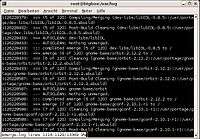less (Unix)
|
less output in an x-terminal | |
| Developer(s) | Mark Nudelman |
|---|---|
| Initial release | 1984 |
| Stable release | |
| Operating system | Cross-platform |
| Type | system utility |
| License |
Simplified BSD License[2] GPL (GNU Version) |
| Website |
www www |
less is a terminal pager program on Unix, Windows, and Unix-like systems used to view (but not change) the contents of a text file one screen at a time. It is similar to more, but has the extended capability of allowing both forward and backward navigation through the file. Unlike most Unix text editors/viewers, less does not need to read the entire file before starting, resulting in faster load times with large files.
History
Mark Nudelman initially wrote less during 1983-85, in the need of a version of more able to do backward scrolling of the displayed text. The name came from the joke of doing "backwards more." To help remember the difference between less and more, a common joke is to say, "less > more," implying that less has greater functionality than more. A similar saying is that "less is more, more or less". less is included in most Unix and Unix-like systems.
Usage
less can be invoked with options to change its behaviour, for example, the number of lines to display on the screen. A few options vary depending on the operating system. While less is displaying the file, various commands can be used to navigate through the file. These commands are based on those used by both more and vi. It is also possible to search for character patterns in the file.
By default, less displays the contents of the file to the standard output (one screen at a time). If the file name argument is omitted, it displays the contents from standard input (usually the output of another command through a pipe). If the output is redirected to anything other than a terminal, for example a pipe to another command, less behaves like cat.
The command-syntax is:
less [options] [file_name]
Frequently used options
-g: Highlights just the current match of any searched string.-I: Case-insensitive searches.-M: Shows more detailed prompt, including file position.-N: Shows line numbers (useful for source code viewing).-S: Disables line wrap ("chop long lines"). Long lines can be seen by side scrolling.-X: Leave file contents on screen when less exits.-?: Shows help.+F: Follow mode for log.
Frequently used commands
| Key | Command |
|---|---|
| Space bar | Next Page |
| b | Previous Page |
| v | Edit Content |
| j or ↵ Enter | Next Line |
| k | Previous Line |
| F | Follow Mode (for logs). Interrupt to abort. |
| g or < | First Line |
| G or > | Last Line |
<n>G |
Line <n> |
/<text> |
Forward Search for <text>. Text is interpreted as a regex. |
?<text> |
Backward Search like / |
| n | Next Search Match |
| N | Previous Search Match |
| Escu | Turn off Match Highlighting (see -g command line option) |
-<c> |
Toggle option <c>, e.g., -i toggles option to match case in searches |
m<c> |
Set Mark <c> |
'<c> |
Go to Mark <c> |
| = or Ctrl+G | File information |
| :n | Next file |
| :p | Previous file |
| h | Help. This is presented with less, q to quit. |
| q | Quit |
Examples
less -M readme.txt # Read "readme.txt"
less +F /var/log/mail.log # Follow mode for log
file * | less # Easier file analysis
less -I -p void *.c # Case insensitive search for "void" in all .c files
Memory considerations
The --buffers=n and --auto-buffers options control how much memory less may use to buffer inputs. This is most relevant when less is directly accessing a named file that is modified or deleted while less is still running, and when less is receiving data from a pipe and the data can not be randomly accessed or regenerated. On the other hand, unlimited buffering means that less will request as much memory as it is fed data, which could drive the system into using virtual memory and swapping a lot of data between RAM and disks (dramatically slowing system performance for most applications on the host), or even further into memory exhaustion where any application on the host requesting memory may have that request denied, or may crash when attempting to access memory that the OS promised but can't find when the application actually attempts to use it and a page-fault occurs. For this reason, some companies/organisations insist that less be used only with fixed buffering - or not at all - on production machines.
Variations
See also
References
- ↑ "less-481 has been released for general use.". Less. 2015-10-16. Retrieved 2015-10-16.
- ↑ Nudelman, Mark. "Less Source version 451". Greenwood Software. Retrieved 18 November 2012.
